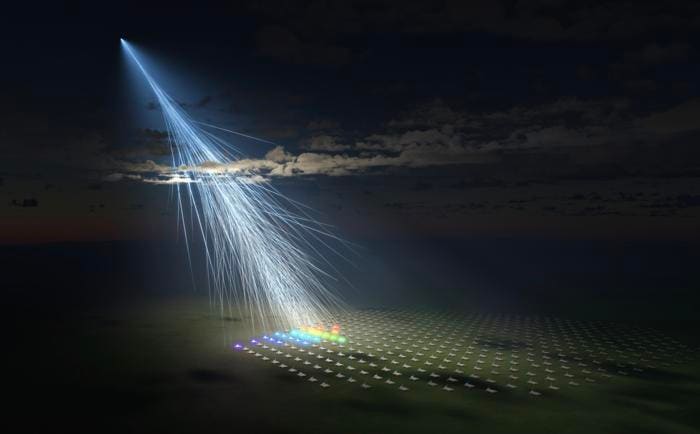A high-energy particle has fallen from space, and scientists have no idea what it is or where it came from. It occurred during an ultra-high-energy cosmic ray event, the likes of which were only detected once before in 1991.
The rare phenomena might follow particle physics unknown to science, said the researchers, whose findings will be published tomorrow in the journal Science.
The particle was named Amaterasu after the sun goddess Shinto beliefs say helped create Japan. It’s the second-highest extreme-energy cosmic ray ever seen after the Oh-My-God particle, detected in 1991.
Echoes Of Violence
According to NASA, cosmic rays are charged particles originating from elsewhere in our galaxy or the universe and they travel close to the speed of light. They are echoes of violent celestial events that are constantly arriving at Earth. However, this event had extraordinary energy and is exceptionally rare.
“When I first discovered this ultra-high-energy cosmic ray, I thought there must have been a mistake, as it showed an energy level unprecedented in the last three decades,” said Toshihiro Fujii, Associate Professor at the Graduate School of Science and Nambu Yoichiro Institute of Theoretical and Experimental Physics at Osaka Metropolitan University.
Extreme Energy
On May 27, 2021, the researchers detected a particle with an extraordinary energy. Scientists say its force is equivalent to dropping a brick on your toe from waist height. It was found using 507 surface detector stations arranged in a square grid that covers 270 square miles (700 square km) near Delta, Utah. The Telescope Array is a specialized cosmic ray detector that has worked since 2008.
The ray appeared to come from the direction of an empty area of space bordering the Milky Way, but there is no obvious source. “You should be able to point to where they come from in the sky,” said John Matthews, Telescope Array co-spokesperson at the University of Utah and co-author of the study. “But in the case of the Oh-My-God particle and this new particle, you trace its trajectory to its source, and there’s nothing high energy enough to have produced it. That’s the mystery of this—what the heck is going on?”
No Explanation
It leaves astrophysicists needing to explain where Amaterasu came from and what it is. “No promising astronomical object matching the direction from which the cosmic ray arrived has been identified, suggesting possibilities of unknown astronomical phenomena and novel physical origins beyond the Standard Model,” said Fujii.
According to CERN, the Standard Model explains how the basic building blocks of matter interact, governed by four fundamental forces. CERN is home to the Large Hadron Collider, the world’s largest and most powerful particle accelerator. Cosmic rays, however, are a million times more powerful than anything that can be created on Earth.
“These events seem like they’re coming from completely different places in the sky. It’s not like there’s one mysterious source,” said John Belz, professor at the University of Utah and co-author of the study. “It could be defects in the structure of spacetime, colliding cosmic strings. I mean, I’m just spit-balling crazy ideas that people are coming up with because there’s not a conventional explanation.”
‘Oh-My-God’ Particle
The detection of the Amaterasu particle during the second highest-energy cosmic ray ever comes 32 years after the first. That particle, detected by the University of Utah Fly’s Eye experiment and dubbed the Oh-My-God particle, had more energy than was theoretically possible for cosmic rays. Astrophysicists were baffled because nothing in our galaxy had the power to produce it. Scientists have detected another 30 ultra-high-energy cosmic rays in the years since, but nothing approached Oh-My-God’s energy until Amaterasu. While Oh-My-God had an estimated energy of 320 EeV when detected in 1991, Amaterasu had 244 EeV.
Scientists will now upgrade the Telescope Array in Utah to see if they can catch more ultra-high-energy cosmic ray events.
Wishing you clear skies and wide eyes.
Read the full article here





